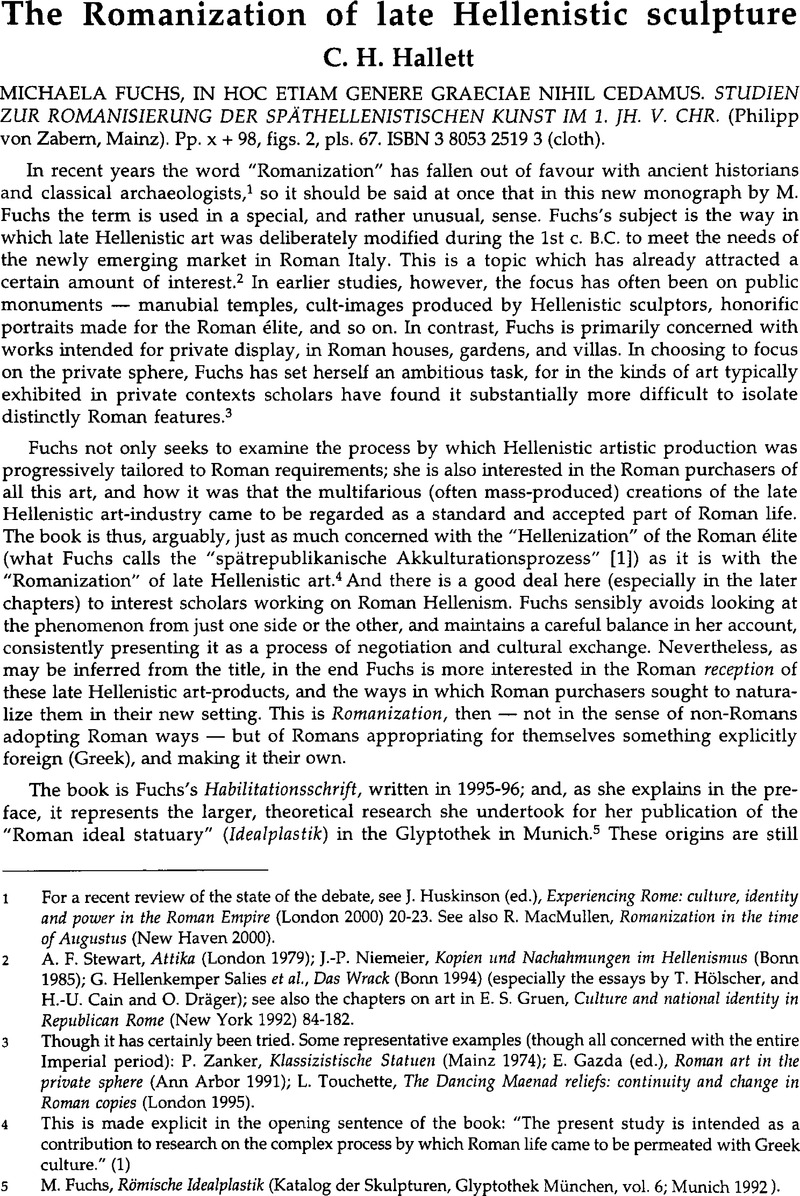No CrossRef data available.
Article contents
The Romanization of late Hellenistic sculpture - Michaela Fuchs, In Hoc Cedamus Etiam Genere Graeciae Nihil. STUDIEN ZUR ROMANISIERUNG DER SPÄTHELLENISTISCHEN KUNST IM 1. JH. V. CHR. (Philipp von Zabem, Mainz). Pp. x + 98, figs. 2, pls. 67. ISBN 3 8053 2519 3 (cloth).
Published online by Cambridge University Press: 16 February 2015
Abstract

- Type
- Reviews
- Information
- Copyright
- Copyright © Journal of Roman Archaeology L.L.C. 2002
References
1 For a recent review of the state of the debate, see Huskinson, J. (ed.), Experiencing Rome: culture, identity and power in the Roman Empire (London 2000) 20–23 Google Scholar. See also MacMullen, R., Romanization in the time of Augustus (New Haven 2000)Google Scholar.
2 Stewart, A. F., Attika (London 1979)Google Scholar; Niemeier, J.-P., Kopien und Nachahmungen im Hellenismus (Bonn 1985)Google Scholar; Salies, G. Hellenkemper et al., Das Wrack (Bonn 1994)Google Scholar (especially the essays by T. Hölscher, and H.-U. Cain and O. Dräger); see also the chapters on art in Gruen, E. S., Culture and iiational identity in Republican Rome (New York 1992) 84–182 Google Scholar.
3 Though it has certainly been tried. Some representative examples (though all concerned with the entire Imperial period): Zanker, P., Klassizistische Statuen (Mainz 1974)Google Scholar; Gazda, E. (ed.), Roman art in the private sphere (Ann Arbor 1991)Google Scholar; Touchette, L., The Dancing Maenad reliefs: continuity and clmnge in Roman copies (London 1995)Google Scholar.
4 This is made explicit in the opening sentence of the book: “The present study is intended as a contribution to research on the complex process by which Roman life came to be permeated with Greek culture.” (1)
5 Fuchs, M., Römische Idealplastik (Katalog der Skulpturen, Glyptothek München, vol. 6; Munich 1992)Google Scholar.
6 The case has perhaps not been made so vigorously since Zanker (supra n.3).
7 Mattusch, C. C., Greek bronze statuary (Ithaca, NY 1988) 77–78 Google Scholar.
8 See, for example, the comments of Smith, R. R. R., Hellenistic sculpture (London 1991) 17–18 Google Scholar.
9 For those scholars who do not wish to accept all of Fuchs's stylistic dates, one can leave aside the Piraeus Kouros, or the Strangford Apollo, for example, and, on the positive side, still accept many of her observations about Archaistic works in general.


